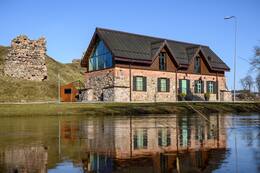Apdovanojimo skyrimo šarvuoto traukinio vadui A. Klestrovui priežastys

Sėkmingai atremdamas priešo ataką, ginkluoto traukinio vadas A. Klestrovas žuvo, o pulkininkas Dankeris išdavė apdovanojimo pagrindą.
„1919 m. lapkritį ginkluoto traukinio „KOLPAKS“ vadas leitenantas KLESTROVAS sumaniai vadovavo traukiniui prieš vokiečius.“
Vokiečiai buvo netoli Liepojos ir nuolat apšaudė stotį ir geležinkelio liniją, kur buvo dislokuotas „KOLPAKS“. Lapkričio 3 d., po vidurdienio, vokiečiai puolė fortus, pradėdami generalinį šturmą prieš Liepoją. Šarvuotas traukinys, vadovaujamas sumaniai vado leitenanto Klestrovo, nepaisydamas nesibaigiančios priešo artilerijos ir kulkosvaidžių ugnies, perėjo į kontrataką. Kai traukinys pasiekė priešo grandines taip, kad patrankos valdyti nebebuvo įmanoma, oberleitenantas Klestrovas ir jo vadovybė, remiami traukinio kulkosvaidžių ugnies, stojo priešui į durtuvų kovą, kurios priešas neatlaikė ir pradėjo trauktis. Sėkmingai persekiojant priešą, oberleitenantas Klestrovas krito nuo priešo kulkos.
Klestrovui buvo suteiktas Laplaso riterių ordino trečiasis laipsnis 1922 m.
1935 m. K. žūties vietoje, Liepojos geležinkelio ir Liepojos-Grubinios plento sankryžoje, pastatyta atminimo lenta.
Susijusios vietos
Paminklas Latvijos armijos leitenantui Alfredui Klestrovui, šarvuotojo traukinio „Kalpaks“ mūšio vieta
Šarvuotojo traukinio vadas leitenantas leitenantas Alfredas Klestrovas, gimęs 1897 m. kovo 8 d. Liepojoje. Baigė Liepojos miesto mokyklą, vėliau – matininkų mokyklą Rygoje.
Pirmojo pasaulinio karo metu pašauktas į Rusijos armiją, baigė bataliono mokyklą Maskvoje. Tarnavo Rumunijos fronte, kovojo Ukrainoje. Kai Ukrainą okupavo vokiečių kariuomenė, grįžo į Rygą.
Ordinas buvo įteiktas 1922 m.
1919 m. pavasarį pašauktas į Latvijos kariuomenę, tarnavo papildomame 3-iosios Latgalos divizijos batalione. 1919 m. spalį paskirtas į šarvuotą traukinį „Kalpaks“ vadu.
1919 m. lapkričio 4 d., vokiečiams puolant Liepoją, šarvuoto traukinio „Kalpaks“ vadas leitenantas Alfredas Kliestrovas, apšaudomas sunkiąja artilerijos ir kulkosvaidžių ugnimi, surengė kontrataką ir su šarvuočiu traukiniu pateko į priešo užnugarį. Nesugebėjęs atidengti patrankų ugnies, jis vadovavo savo komandai durtuvų mūšyje ir išsklaidė priešą, taip prisidėdamas prie bermontiečių puolimo atsitraukimo, tačiau pats šiame mūšyje žuvo nuo vokiečių kareivių, kurie buvo įsitvirtinę namuose ir liko už Latvijos armijos kareivių nugaros, kulkos.
1935 metais Liepojos geležinkelio ir Liepojos-Grubinios plento sankryžoje, šarvuoto traukinio „Kalpaks“ vado leitenanto Alfredo Klestrovo žūties vietoje, buvo pastatyta atminimo lenta.
Laisvosios valstybės brangenybių namai
Nepriklausomos valstybės palikimą saugantys namai yra šalia Rėzeknės pilies griuvėsių.
Išskirtinėje ekspozicijoje pristatoma keli šimtai istorinių eksponatų iš Latvijos ir užsienio privačių kolekcijų, apimančių 1918–1940 m. laikotarpį, bei skirtingus Latgalos ir Rėzeknės istorijos puslapius. Supažindinama su Pirmosios nepriklausomos Latvijos valstybės karinių ir civilinių apdovanojimų istorija, įvairių valstybinių ir visuomeninių organizacijų veikla, vykusia nuo Latvijos nepriklausomybės karo iki Antrojo pasaulinio karo.
Tai didžiausia Latvijoje kolekcija, pristatanti nepriklausomos valstybės karinius ir civilinius apdovanojimus bei skiriamuosius ženklus.
Antrajame aukšte įrengta keičiamų parodų salė, kurioje bent kartą per metus surengiama nauja paroda. Lankytojai jau turėjo galimybę pamatyti išskirtinę porceliano dirbinių kolekciją, prabangius laikrodžius iš Prancūzijos ir įvairius Latgalos peizažus vaizduojančius paveikslus.






